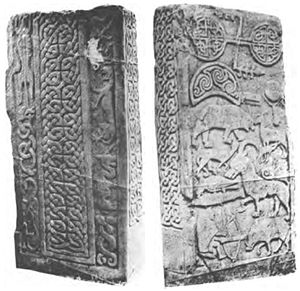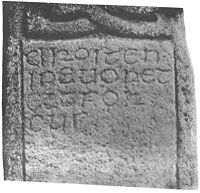- Drosten Stone
-
The Drosten Stone is a carved Pictish stone of the 9th century at St Vigeans, near Arbroath, Scotland. In academic contexts it is sometimes called St Vigeans 1. The Drosten Stone is a Class 2 cross-slab: a flat rectangular stone with a cross carved on one side and symbols on the other. The stone is unusual in having a non-ogham inscription.
The inscription is read as:
DROSTEN:
IPEUORET
[E]TTFOR
CUSThomas Owen Clancy has interpreted the text as Goidelic, giving Drosten, i ré Uoret ett Forcus (Drosten, in the time of Uoret, and Forcus). Clancy notes three possibilities for the origin of the stone. One is as a monument to a noble or ecclestiastic called Drosten, a common Pictish name related to Tristan, who died in the reign of Uoret and Fergus. The second possibility is a dedication to the popular Pictish Saint Drostan, or perhaps to Saints Drostan and Fergus. The final possibility noted by Clancy is that Drosten and Fergus had the stone made. Clancy believes the stone should be dated to the reign of the Pictish king Uurad (i.e. Uoret) (839–842), again, an unusual feature in that Pictish stones can rarely be so precisely dated.
References
- Clancy, Thomas Owen (1993), "The Drosten Stone: a new reading", Proceedings of the Society of Antiquaries of Scotland 123: 345–353, http://ads.ahds.ac.uk/catalogue/adsdata/PSAS_2002/pdf/vol_123/123_345_353.pdf, retrieved February 5, 2010
External links
- Proceedings of the Society of Antiquaries of Scotland at the Archaeology Data Service
- CISP database entry (Celtic Inscribed Stones Project)
- St Vigeans Museum details at the Historic Scotland website
Aberlemno Sculptured Stones · Bullion Stone · Camus Cross · Drosten Stone · Dunnichen Stone · Dupplin Cross · Eassie Stone · Glamis Manse Stone · Hunter's Hill Stone · Meigle standing stones · Monifieth Sculptured Stones · St Orland's Stone · Woodwrae StoneCategories:
Wikimedia Foundation. 2010.


